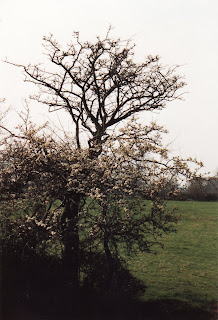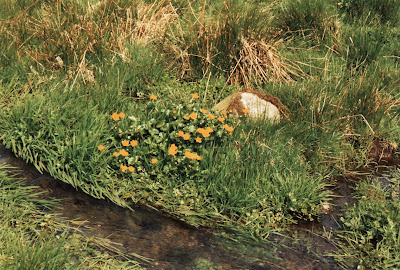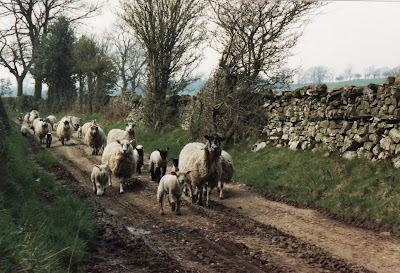Eliot's Prufrock measured out his life in coffee spoons. I think I could measure mine out in music, paintings, people or literature. Juliet of Crafty Green Poet suggested that I chart the twenty-five pieces of literature which have really influenced me in my life. It has taken some doing but has been a real walk down memory lane. It would be interesting to do the same thing with people who have influenced me - so shall try that another time.
If we are sensible we do not go into old-age (whenever that is) without continuing to learn, question and try to grow old disgracefully (and I am wearing a purple jumper as I write, in deference to Jenny Joseph's poem!) I certainly intend to continue in that mould, so will not guarantee that the pieces I choose will not change in the years to come. But then, they are not written in stone, are they? So here they are:-
I can't remember learning to read and, apart from my Dad's poetry books, I don't remember anything but library books around the house. I don't think we had the money to buy books, but my Mother was an ardent library-goer.## We took a daily newspaper and there was always a world atlas lying around. So that is where my reading began.
The first book I actually owned was called "Claudius the Bee". It was bought for me by my brother and I treasured it for many years. It was a fictionalised account of life in the hive. So that shall be number one.
Number Two would be my much older sister's Film Annuals. She married when I was very small and as soon as I could read she passed these one to me. It was from them that I learned about the old silent film stars - Jean Harlow, Nova Pilbeam, Rudolph Valentino - I can still see the photographs of them in my mind's eye.
My father's poetry books would be at Number Three. He belonged to that age when you learned poetry off by heart at school and I grew up on a diet of "The Wreck of the Hesperus", "The Battle of Blenheim", "The Jackdaw of Rheims" and "Gray's Elegy."
4. My infant school teacher, Miss Smith, was an ardent Walter de la Mare fan. I think the first poem I ever learned was "Someone came a knocking at my wee small door."
5. At Lincoln Girls' High School I became mad about Shakespeare's plays - I can still recite large chunks off by heart - Hamlet's soliloquys, Macbeth's speeches.
6. Mrs Gaskell's "Cranford" was another favourite - and the recent TV adaptation brought the memories of it flooding back.
7. When I was a teenager, foreign travel for people like me was just a dream - but I was mad keen to get abroad. I travelled vicariously - first of all with Maurice le Toumelin in "Kurun around the world" - he sailed round the world in a ketch. I read that book a hundred times, desperate to feel some of the excitement.
8. When I moved into an urban environment after marriage I was desperate to keep my links with the countryside I loved, so I read Flora Thompson's "Lark Rise to Candleford" - I still have the copy I bought then and I still dip into it from time to time.
9. I became a keen gardener and my bible was always Vita Sackville-West's "Garden Diary".
10. I am a big believer in reading to children, even when they can read for themselves. I love to listen to books being read aloud even now. The first book I remember reading to my son was Dr. Seuss's "The Cat in the Hat Comes Back." - lovely rhyming sentences.
11. Ladybird Books were a good stand-by - his favourite (and mine) was "Lazy Little Piggly Wriggly" - I can still recite chunks and I bet he can too (Dominic - finish this verse - Lazy Little Piggly Wriggly, always stayed in bed to snore/after Mother Pig had called him?.......)
12. And then of course there was the sheer excitement (which we still both share) of the Arthur Ransome books.
13. My College and University days brought with them an inspirational English lecturer, Dave Harper, who introduced me to so much good literature. The poetry of RS Thomas was a revelation to me - and still is. At the moment my favourite poem of his is "Arrival" but no doubt it will change on my next reading.
14. The novels of F Scott Fitzgerald were another of his passions which I picked up - particularly "The Great Gatsby".
15. The metaphysical poets - in particular John Donne.
16. I did my final thesis on the plays of Edward Albee - these seem a bit old hat now - but golly I did a lot of work on them at the time, and they are still firmly ingrained in my memory.
17. Many years ago a friend bought me a copy of Shakespeare's sonnets, all written out in beautiful calligraphy - the joy of reading them and at the same time admiring the exquisite writing has made them a firm favourite still.
18. I can't remember when I discovered Evelyn Waugh's novels - but I love them still - and "Brideshead Revisited" is still my joint-favourite novel.
19. My other joint-favourite is EM Forster's "A Passage to India" - the enjoyment of that was enhanced by reading an essay by him on how he came to write it.
20. Many years ago TV did an adaptation of C.P. Snow's "Strangers and Brothers" - as a result of watching that I bought the novels, and although they are a little dated now, I still enjoy reading them.
21. I have never lost my love of travel books - although I am lucky enough to have been able to travel fairly widely over the years I still enjoy the vicarious pleasure to be had from Gavin Young's "Slow Boat to China" and Paul Theroux's "The Great Railway Bazaar" - and that all-time favourite Wilfred Thesiger's "Arabian Sands" about the empty quarter, which has fairly recently been reissued and sings just as much as it did the first time.
22 and 23 - My love of poetry, started by my Dad a long time ago, means that I could list twenty poets I love - but I will choose just two - Edward Thomas and Edwin Morgan (Heron - one of the most evocative nature poems I have ever read).
24 and 25. My love of the countryside means that my last - but by no means least - two must be nature books. I fully recommend the books of Ronald Blythe - he has such a wealth of knowledge on natural history/literature and is a past master at linking the two together. John Lister-Kaye (in particular "Nature's Child") also catches my imagination when he writes so beautifully about the wildlife he loves.
So there it is - a long post for me. Not particularly high-brow - but it represents a lifetime's love or reading.
## My mother died in 1972 - if she were doing this list, two books would dominate, and although they would never be on my list - seeing her reading them time and time again had a profound influence of my learning that reading was a joy. Those two books were Lady Eleanor Smith's "Red Wagon." and Baroness Orczy's "The Scarlet Pimpernel."







